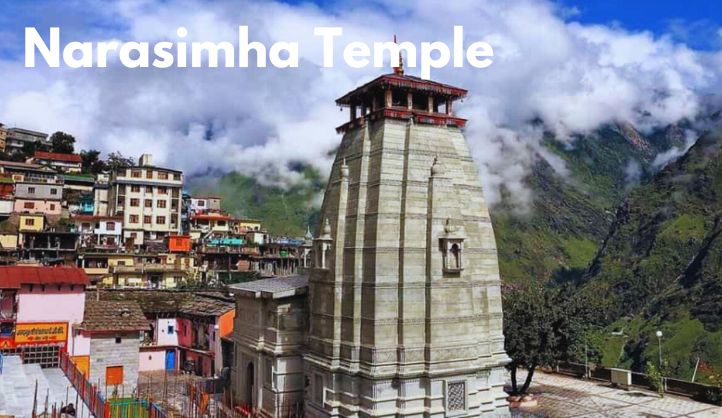Nestled in the serene town of Joshimath in Uttarakhand, Narasimha Temple stands as a beacon of faith and history. This ancient temple, dedicated to Lord Narasimha, an avatar of Lord Vishnu, is not just a place of worship but a site that intertwines mythology, spirituality, and the scenic beauty of the Himalayas. Join us on a journey to explore the depths of Narasimha Temple, where faith meets heritage.
A Glimpse into Joshimath
The Gateway to Sacred Pilgrimages
Joshimath, also known as Jyotirmath, is a small but significant town in Uttarakhand. It serves as the winter seat of Lord Badrinath and is one of the four ‘Mathas’ established by Adi Shankaracharya in the 8th century. This town is a spiritual hub, offering a serene environment for pilgrims and travelers alike.
The Scenic Beauty
Perched at an elevation of 1,875 meters, Joshimath provides breathtaking views of the snow-capped peaks and lush green valleys. The tranquil Alaknanda River flows by, adding to the town’s charm. The journey to Joshimath itself is an experience, with winding roads, verdant forests, and glimpses of the majestic Himalayas.
How to Reach
By Air
The nearest airport is Jolly Grant Airport in Dehradun, approximately 270 kilometers away. From the airport, one can hire a taxi or take a bus to Joshimath.
By Train
The closest railway station is Rishikesh, about 250 kilometers from Joshimath. Regular buses and taxis are available from Rishikesh to Joshimath.
By Road
Joshimath is well-connected by road to major cities in Uttarakhand. Buses and taxis are readily available from Haridwar, Rishikesh, and Dehradun.
Map of Narasimha Temple
The Legend of Narasimha Temple
The Avatar of Protection
The Narasimha Temple is dedicated to Lord Narasimha, the fourth incarnation of Lord Vishnu. According to Hindu mythology, Lord Narasimha appeared in the form of a half-man, half-lion to save his devotee Prahlada from the tyranny of his father, the demon king Hiranyakashipu. This avatar symbolizes the victory of good over evil and the protection of devotees.
The Sacred Idol
The temple houses a unique idol of Lord Narasimha, carved out of a single black stone. The idol depicts Lord Narasimha in a seated position with a fearsome expression, showcasing his lion’s head and human torso. It is believed that the idol has been gradually shrinking over the years, and legend has it that the day it completely vanishes, the road to Badrinath will become inaccessible.
Architecture and Design
A Blend of Styles
The Narasimha Temple is a marvel of ancient architecture, blending traditional North Indian and Himalayan styles. The temple’s structure, made of stone, showcases intricate carvings and detailed sculptures, reflecting the craftsmanship of the bygone era.
The Sanctum Sanctorum
The inner sanctum of the temple, where the idol resides, is a small yet highly revered space. Devotees throng this area to offer their prayers and seek blessings. The sanctum is adorned with traditional motifs and religious symbols, creating an atmosphere of deep spirituality.
The Temple Complex
Surrounding the main temple, the complex includes smaller shrines dedicated to various deities. The tranquil courtyard, with its ancient trees and stone pathways, provides a serene environment for meditation and reflection.
Celebrating Faith
Narasimha Jayanti, the birthday of Lord Narasimha, is the most significant festival celebrated at the temple. Devotees from far and wide gather to participate in the elaborate rituals, including special prayers, chanting of hymns, and the ceremonial procession of the deity.
Daily Rituals
The temple follows a strict schedule of daily rituals, starting with the morning ‘Aarti’ and concluding with the evening prayers. These rituals, performed by the temple priests, maintain the sanctity and spiritual energy of the temple.
The Winter Seat of Badrinath
During the winter months, when the Badrinath Temple remains closed due to heavy snowfall, the idol of Lord Badrinath is brought down to Narasimha Temple. This tradition underscores the temple’s importance and its integral role in the Char Dham Yatra.
Best Time to Visit
The ideal time to visit Narasimha Temple is from April to November. During these months, the weather is pleasant, and the roads to Joshimath are accessible. The temple sees a significant influx of pilgrims during the festival of Narasimha Jayanti, making it an ideal time for those looking to experience the temple’s vibrant culture.
A Journey of Faith
Visiting Narasimha Temple is more than just a religious trip; it is a journey of faith and self-discovery. The serene environment, coupled with the spiritual aura of the temple, provides an ideal setting for introspection and inner peace.
Nearby Places to Explore
1. Auli: The Skiing Paradise
Auli is a popular hill station and skiing destination, located about 16 kilometers from Joshimath. Known for its pristine slopes and stunning views of the Himalayas, Auli attracts adventure enthusiasts and nature lovers alike.
- Skiing and Snowboarding: Auli offers some of the best skiing slopes in India. During winter, the town transforms into a snowy wonderland, perfect for skiing and snowboarding.
- Auli Ropeway: The Auli Ropeway, one of the longest ropeways in Asia, provides a thrilling ride with breathtaking views of the surrounding mountains.
- Artificial Lake: The artificial lake in Auli is one of the highest man-made lakes in the world. It helps in creating artificial snow for skiing during the winter season.
2. Vishnuprayag
Vishnuprayag is one of the Panch Prayag (five confluences) of the Alaknanda River, located at the confluence of the Alaknanda and Dhauliganga rivers. It is a sacred site for Hindus and offers serene natural beauty.
- Vishnu Temple: The Vishnu Temple at Vishnuprayag is an ancient shrine dedicated to Lord Vishnu. It is a peaceful place for prayer and meditation.
- Scenic Beauty: The confluence of the two rivers amidst the lush green mountains provides a picturesque setting for nature lovers and photographers.
3. Nanda Devi National Park
Located about 23 kilometers from Joshimath, Nanda Devi National Park is a UNESCO World Heritage Site known for its unique flora and fauna. It is part of the larger Nanda Devi Biosphere Reserve.
- Biodiversity: The park is home to a variety of rare and endangered species, including the snow leopard, Himalayan musk deer, and several species of birds.
- Trekking: The park offers several trekking routes that provide stunning views of the Nanda Devi peak and the surrounding landscapes.
- Flora: The park is rich in alpine vegetation, with beautiful meadows of flowers that bloom during the summer months.
4. Kalpeshwar Temple
Kalpeshwar Temple, one of the Panch Kedar temples, is dedicated to Lord Shiva. It is located about 23 kilometers from Joshimath and can be reached by a trek from the village of Urgam.
- Spiritual Significance: Kalpeshwar Temple is the only Panch Kedar temple that remains open throughout the year. It is believed that Lord Shiva’s hair (Jata) appeared here.
- Scenic Trek: The trek to Kalpeshwar Temple passes through beautiful forests, villages, and terraced fields, offering a serene and scenic journey.
5. Tapovan Hot Springs
Tapovan, located about 15 kilometers from Joshimath, is known for its natural hot springs and stunning views of the Himalayan peaks.
- Hot Springs: The natural hot springs at Tapovan are believed to have therapeutic properties and are a popular spot for relaxation.
- Panoramic Views: Tapovan offers panoramic views of the surrounding mountains, including the famous peaks of Nanda Devi and Dronagiri.
6. Badrinath Temple
One of the most revered Hindu shrines, Badrinath Temple, is located about 45 kilometers from Joshimath. It is part of the Char Dham and Chota Char Dham pilgrimage circuits.
- Spiritual Experience: Badrinath Temple is dedicated to Lord Vishnu and is considered one of the holiest temples in Hinduism. The temple’s architecture and spiritual aura attract millions of devotees every year.
- Tapt Kund: A natural hot spring near the temple, where pilgrims take a holy dip before entering the temple.
- Neelkanth Peak: The stunning Neelkanth Peak forms a majestic backdrop to the Badrinath Temple and is a sight to behold, especially at sunrise.
7. Hemkund Sahib
Hemkund Sahib is a revered Sikh Gurudwara located about 43 kilometers from Joshimath. Situated at an altitude of 4,329 meters, it is one of the highest gurudwaras in the world.
- Spiritual Trek: The trek to Hemkund Sahib is challenging but rewarding, with breathtaking views of snow-capped peaks and alpine meadows.
- Glacial Lake: The Gurudwara is located near a stunning glacial lake, which is considered sacred by both Sikhs and Hindus.
- Flora and Fauna: The trek passes through the Valley of Flowers, a UNESCO World Heritage Site known for its diverse and vibrant floral species.
Conclusion
Narasimha Temple in Joshimath is a testament to India’s rich spiritual heritage and architectural prowess. Whether you are a devout pilgrim or a curious traveler, a visit to this ancient temple is bound to leave a lasting impression. As you stand before the idol of Lord Narasimha, you feel a deep connection to the divine, a sense of peace, and the timeless power of faith.
FAQs of Narasimha Temple
1. What is the significance of the Narasimha Temple in Joshimath?
Narasimha Temple is a significant spiritual site dedicated to Lord Narasimha, an avatar of Lord Vishnu. It is revered for its ancient idol and its role as the winter seat of Lord Badrinath.
2. When is the best time to visit Narasimha Temple?
The best time to visit is from April to November, when the weather is pleasant, and the roads are accessible. Narasimha Jayanti, the birthday of Lord Narasimha, is also a significant time to visit.
3. How can I reach Narasimha Temple?
Joshimath is accessible by air (via Dehradun’s Jolly Grant Airport), by train (via Rishikesh), and by road from major cities like Haridwar, Rishikesh, and Dehradun.
4. What are the daily rituals at Narasimha Temple?
The temple follows a daily schedule of rituals, starting with the morning ‘Aarti’ and concluding with the evening prayers, maintaining the temple’s sanctity.
5. What architectural style is Narasimha Temple known for?
Narasimha Temple features a blend of traditional North Indian and Himalayan architectural styles, with intricate carvings and sculptures.
6. Are there accommodation options near Narasimha Temple?
Yes, Joshimath offers a range of accommodation options, including budget hotels, guesthouses, and government-run guesthouses with basic amenities.





